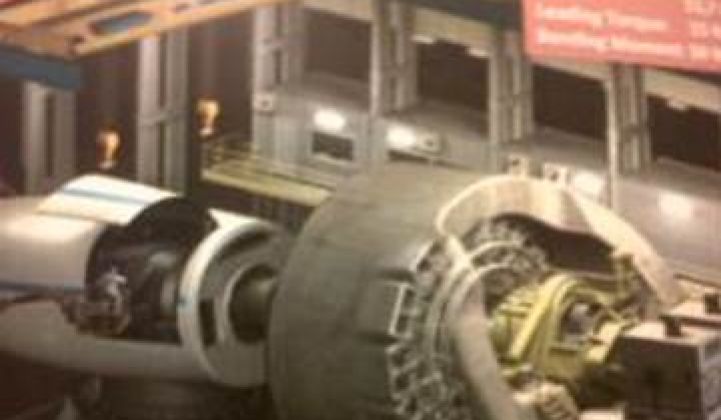Top wind industry CEOs agreed, in a key Windpower 2011 panel discussion that happened to fall on Bob Dylan’s 70th birthday, that uncertainty stemming from a failure of policy support is a troubling answer for them in the U.S. political winds. Power from wind turbines, the American Wind Energy Association said, depends on power on Capitol Hill.
Hoped-for growth-driving measures, like a national Renewable Energy Standard (RES) requiring utilities to obtain a portion of their power from renewables, disappeared with last year’s proposals for an energy bill.
The cash grant in lieu of tax credits, a key incentive provided by the 2009 Democratic Congress to get the industry through the Great Recession, will expire at the end of this year and is not expected to be resuscitated by the current budget-conscious Congress.
Only the Production Tax Credit (PTC), the industry’s longtime workhorse, looks likely to survive, though that is by no means certain. The Investment Tax Credit (ITC), extended as an alternative to the PTC to attract different investors and different capital, is even more in doubt.
The status of both the PTC and ITC could remain uncertain until late next year. When wind representatives approach members of Congress about a long-term extension of the tax credits, said Steve Trenholm, the CEO of E.ON Climate and Renewables, “their response is, ‘Why are you talking to us now? It goes on for another year.’ Our company wants to invest and it wants to invest now, but it’s really hard to make that investment without long-term certainty.”
Vic Abate, the Vice President for Renewables at GE Energy, was just as blunt. “If we don’t have a PTC by the middle of next year, factories are going to start shutting down.”
The answer to a call for support issued by the most successful U.S. renewables industry seems to be blowing away.
Another answer in the wind seems friendlier. Timothy Kemper, Regional Managing Partner with the Reznick Group of accounting, tax and business advisors to the wind industry, said the likelihood of the PTC being extended is good and added that the likelihood of the ITC option being included is equally good.
“The impression I get is that there’s support in Congress for an extension of both,” Kemper, who has lobbied on Capitol Hill, said. “Neither requires a change in the Internal Revenue code. All it requires is a date extension.” In negotiations with lobbyists, Kemper said he has found that “that’s a little bit easier of a sell right now.”
Like most other Congress watchers, Kemper noted there is bipartisan support for wind and other renewables. It is a matter of finding politically acceptable means. “I haven’t seen the CBO scoring,” Kemper said, referring to the budgetary cost score assessed by the Congressional Budget Office, “but I wouldn’t think it would be a significant change” from the present budget.
Whether the tax credits can be extended for longer than a year remains unpredictable. It is possible, Kemper said, that if the wind industry can muster an effort this year, rather than wait until the election year of 2012, it might have a better chance for a longer-term extension.
“Go now,” Kemper said, before the makeup of the Senate becomes more like that of the House -- or before defeated Senate and House Republicans become more intransigent on spending.
Winds of technology innovation carry the best answers for the industry. “Every OEM [original equipment manufacturer] is introducing advanced technology machines,” said Abate.
GE’s 1.5-megawatt workhorse has been replaced as an industry standard. Both 2.5-megawatt and 3.0-megawatt turbines with more sophisticated yet more maintenance-free mechanical engineering and advanced electrical engineering are now so commonplace that the Chinese government recently announced new rules for its manufacturers designed to drive out OEMs not capable of building 2.5-megawatt machines.
But that’s just the beginning. A $98 million test facility for next-generation wind turbines has begun construction under the auspices of Clemson University’s Restoration Institute in Charleston, South Carolina. Funded with $45 million in Recovery Act money and $53 million from private sources (including local philanthropists), the center will test drive trains and direct drives for turbines from 7.5 megawatts to 15 megawatts.
Expected to be ready to test in 2012, the 82,000-square-foot facility will house a huge Renk-constructed actuator system that will be attached to drivetrains mounted on a mock tower. It will simulate the thrust and movement effects of wind-driven turbine rotors.
At the test center, a new generation of turbines, suited primarily for untapped offshore wind riches, can prove ready to set to sea. “They’re building the prototypes now,” said Clemson University Director of Business Development Elizabeth Colbert-Busch.
No OEMs have contributed to the building of the test facility and the research will be conducted without prejudice. The derived data will be proprietary. The economic benefits of the center, though, will be plentiful and will benefit the public. It will create 24 full-time jobs and host hundreds of workers and researchers. It is also expected to generate spinoffs.
“This project spurred four other projects. Talk about stimulus,” Colbert-Busch said, referring to the big funding boost that came from the DOE. “We’re looking at a potential next-generation bearings test facility. And we’re going to build a grid simulator to test for impacts from 15-megawatt turbine interconnections.” They are planning, she said, “an energy systems testing park.”
Because out where the wind is blowing is where the real answer is.



